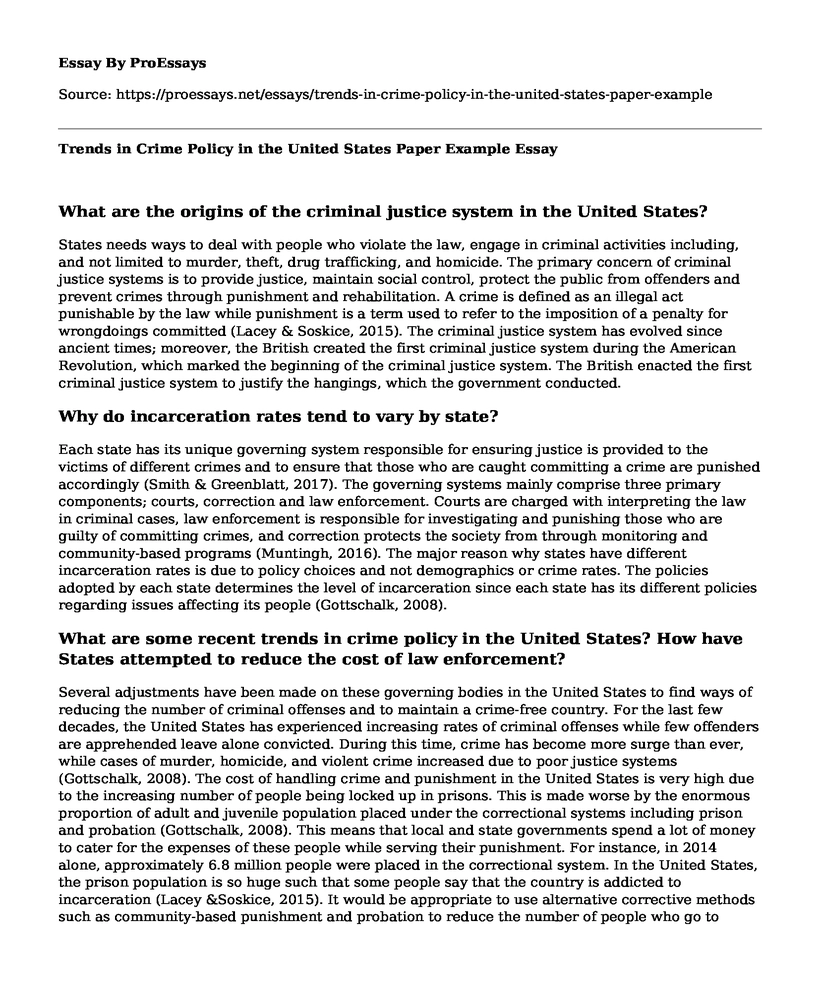What are the origins of the criminal justice system in the United States?
States needs ways to deal with people who violate the law, engage in criminal activities including, and not limited to murder, theft, drug trafficking, and homicide. The primary concern of criminal justice systems is to provide justice, maintain social control, protect the public from offenders and prevent crimes through punishment and rehabilitation. A crime is defined as an illegal act punishable by the law while punishment is a term used to refer to the imposition of a penalty for wrongdoings committed (Lacey & Soskice, 2015). The criminal justice system has evolved since ancient times; moreover, the British created the first criminal justice system during the American Revolution, which marked the beginning of the criminal justice system. The British enacted the first criminal justice system to justify the hangings, which the government conducted.
Why do incarceration rates tend to vary by state?
Each state has its unique governing system responsible for ensuring justice is provided to the victims of different crimes and to ensure that those who are caught committing a crime are punished accordingly (Smith & Greenblatt, 2017). The governing systems mainly comprise three primary components; courts, correction and law enforcement. Courts are charged with interpreting the law in criminal cases, law enforcement is responsible for investigating and punishing those who are guilty of committing crimes, and correction protects the society from through monitoring and community-based programs (Muntingh, 2016). The major reason why states have different incarceration rates is due to policy choices and not demographics or crime rates. The policies adopted by each state determines the level of incarceration since each state has its different policies regarding issues affecting its people (Gottschalk, 2008).
What are some recent trends in crime policy in the United States? How have States attempted to reduce the cost of law enforcement?
Several adjustments have been made on these governing bodies in the United States to find ways of reducing the number of criminal offenses and to maintain a crime-free country. For the last few decades, the United States has experienced increasing rates of criminal offenses while few offenders are apprehended leave alone convicted. During this time, crime has become more surge than ever, while cases of murder, homicide, and violent crime increased due to poor justice systems (Gottschalk, 2008). The cost of handling crime and punishment in the United States is very high due to the increasing number of people being locked up in prisons. This is made worse by the enormous proportion of adult and juvenile population placed under the correctional systems including prison and probation (Gottschalk, 2008). This means that local and state governments spend a lot of money to cater for the expenses of these people while serving their punishment. For instance, in 2014 alone, approximately 6.8 million people were placed in the correctional system. In the United States, the prison population is so huge such that some people say that the country is addicted to incarceration (Lacey &Soskice, 2015). It would be appropriate to use alternative corrective methods such as community-based punishment and probation to reduce the number of people who go to prison (Stucky, 2013). This will consequently assist in reducing the cost of operating the governing systems and law enforcement.
References
Gottschalk, M. (2008). The Worlds Warden: Crime, Punishment, and Politics in the United States. Dissent, 55(4), pp.58-66. Retrieved from https://muse.jhu.edu/article/441136/pdf
Lacey, N. and Soskice, D. (2015). Crime, punishment, and segregation in the United States: The paradox of local democracy. Punishment & Society, 17(4), pp.454-481. Retrieved from https://journals.sagepub.com/doi/abs/10.1177/1462474515604042?journalCode=puna
Muntingh, L. (2016). Punishment and deterrence: Don't expect prisons to reduce crime. South African Crime Quarterly, (26).Smith, K. and Greenblatt, A. (2017). Governing states and localities. 6th ed. Washington, DC: CQ Press.
Stucky, T. (2013). Crime, Politics, and Punishment: Criminological Research for Political Sociologists. Sociology Compass, 7(7), pp.561-572. Retrieved from https://www.sciencedirect.com/science/article/pii/S0049089X00906860
Cite this page
Trends in Crime Policy in the United States Paper Example. (2022, Oct 10). Retrieved from https://proessays.net/essays/trends-in-crime-policy-in-the-united-states-paper-example
If you are the original author of this essay and no longer wish to have it published on the ProEssays website, please click below to request its removal:
- Changing the Texas Constitution Essay Example
- Research Paper on Disparities and Strategies to Achieve Social and Justice
- Essay Example on Freedom of Expression: From Ancient Times to Contemporary Society
- Essay Example on American History X: Racism in America's Colorblind Society
- Racial Disparity in Marijuana Use in America - Essay Sample
- Black Looks, White Justice: Capital Punishment & Stereotypical Black Features - Essay Sample
- Essay Example on Ohio State: A Midwestern State in the US







